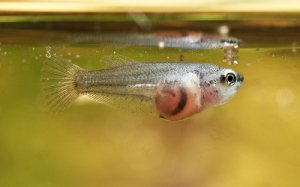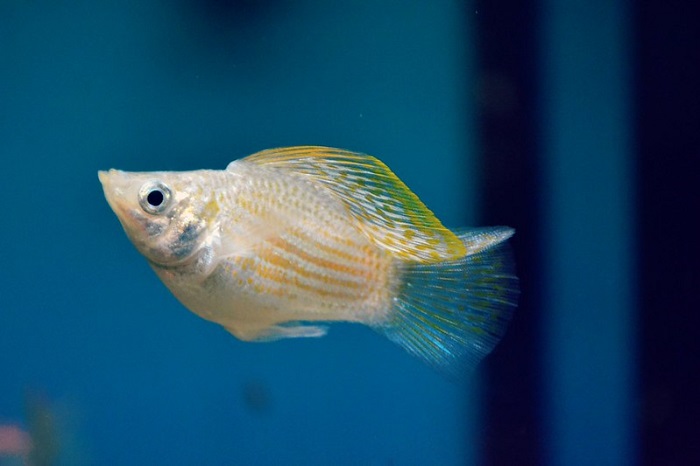
Molly fish are one of the easiest species of freshwater aquarium fish, and that’s for a good reason. These livebearing fish – in the family Poecilidae with other livebearers such as guppies, platies, and swordtails – mate so readily that it is even recommended to increase the number of females to males, so you don’t end up with too much unwanted mating.
As a result, it’s highly likely that you may end up with some unwanted fish pregnancy on your hands – or even wanted. Either way, it’s important to know what to look out for and how to spot signs your Molly Fish is about to give birth, as mating, pregnancy, gestation, and labor are all vulnerable times for this small but fascinating fish. Read on to find out what to look for.
Is My Molly Fish Pregnant?
In the early stages of Molly Fish pregnancy, it may be that you confuse the symptoms with some other conditions for fish, such as digestive issues, bloating, or even a serious disease called dropsy. However, in the later stages of Molly Fish pregnancy, it becomes unmistakable that your female molly is carrying fry.
How To Spot A Pregnant Molly Fish
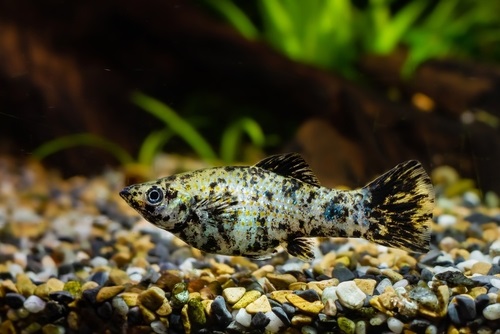
A pregnant Molly Fish is very visible with a heavily distended abdomen that curves out from underneath the fish’s body in a C shape. However, beyond this, there are also other signs of pregnancy you can spot. These include the following:
1. Gravid Spot
The gravid spot is a dark spot near the tail of your fish that starts off as a pale color and gradually darkens to black further into the gestation period. In it, you will be able t see the growing fish fry inside the mother’s body.
However, the gravid spot is not the only appearance change that you will see with a pregnant Molly Fish. In addition to this and your molly’s rounded stomach, in the later stages of pregnancy, you may even be able to see through your fish’s body into the uterus where the eyes of the fish fry are visible as small black dots.
Author’s Note: Small white dots can sometimes appear around the gravid spot when your molly is approaching the time of giving birth. These indicate that baby fish will follow not long after!
2. Behavioral Changes
Behavioral changes in pregnancy Molly Fish are possible to mistake for disease, but when you are familiar with molly behavior, you will notice that there are significant differences. One of the main changes is that your fish may hide or seem relatively lethargic. Fish may become shyer and less curious, exploring the tank less frequently than they did before.
In these circumstances, you may fear that your fish is sick, but so long as she is eating, it is more likely these changes point to pregnancy as opposed to disease. Remember that when carrying eggs your molly’s natural instincts hardwire her to want to defend them and keep herself safe so that no harm comes to the growing young. As a result, she may be less feisty than usual. However, if she does not show other sins of disease like difficulty staying afloat, sore or ragged fins, or difficulty swimming, it’s safe to say that you may soon have baby fish in your tank.
Author’s Note: Increased appetite really is an important change during female Molly Fish pregnancy. In fact, this is because your fish is eating not only the amount normally needed for her to swim and stay alive, but also enough to create the growing fish fry in her uterus. Therefore, you may find she needs more protein, and indeed, feeding more protein and feeding little and often can help ensure your fish is strong enough that there are no complications during the pregnancy.
3. The Mating Process
Last but not least, if you have spotted your Molly Fish mating, and your female molly then shows some of the above symptoms, it’s highly likely that your fish is pregnant. Molly fish mating happens quickly and can be mistaken for run-of-the-mill tank disputes or chasing behavior. It can also be affected by the presence of competing fish, so a good environment is best to facilitate mating.
In the mating process, the male fish insets a specialized anal fin called a gonopodium into the female’s vent in order to fertilize the eggs that she is carrying in her body. This is the part that happens very quickly and that you may miss, although the courtship that leads up to it is easy to notice if you know what to look for.
Author’s Note: Once fertilized, the eggs inside your female Molly fish’s body will grow into young fish (fry) and when she is ready to give birth she will push them out of her body where they are then immediately able to start swimming.
Molly Fish Pregnancy Cycle
Overall, the Molly Fish pregnancy cycle is relatively short and simple. Starting with the courtship process and ending with the birth of the fry, if you are taking good care of your fish it is most likely you will see all or some of it at some point. In fact, if you know what you are doing, it is easy to take care of pregnant Molly Fish.
In the end, the entire process takes about 4-6 weeks, which is longer than many egg-laying fish which lay eggs that hatch within 2-4 days. It may seem like a while, but take good care of your fish in a breeding tank, and before you know it, they will be giving birth.
Top 5 Molly Fish Giving Birth Signs
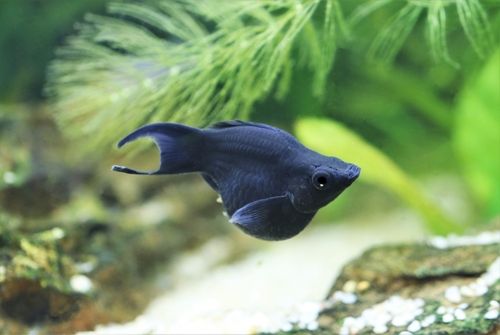
1. Hiding
As explained earlier in the article, your Molly Fish hiding is a sign of pregnancy that can easily worry beginner fishkeepers as it’s also possible to mistake it for a sign of disease. However, in the later stages of pregnancy, before she is about to give birth, you will notice your Molly Fish hiding with a different intent.
Because in the wild Mollies and their fry are small enough to be potential food for a wide variety of predators, including larger fish, birds, and frogs, your Molly is looking for a safe place to give birth as during the labor process she will be unable to swim away from any danger.
Thus, somewhere that is sheltered and away from the rest of the tank is often a most popular place for pregnant Mollies to give birth. If you have a corner of the tank that is heavily planted, do not be surprised if your Molly Fish makes a beeline for this before giving birth. Molly Fish will hang around near the bottom of the tank near the gravel, when they are giving birth, as here they spend less effort staying afloat.
Other Behavioral Changes
Apart from hiding, Molly Fish may display other behavioral changes before giving birth such as acting more defensive towards other fish or avoiding them. As the growing fry require more oxygen, you may also see female Mollies breathing from the surface more frequently in the late stages of pregnancy. In addition, if you have a heater, some fishkeepers report that Mollies will hang around near this heater as the warm temperatures facilitate the birthing process.
Appetite Loss:
Right before giving birth, despite her increased appetite throughout the rest of the gestation period, the female Molly will lower her appetite, as feeding will interfere with the delivery of the fry.
2. Dark Gravid Spot
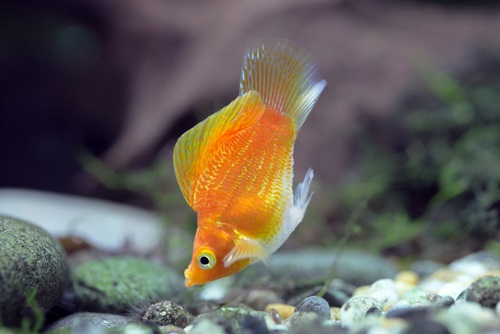
The dark color of the gravid spot is another surefire indicator that your Molly Fish is near giving birth. In the very latest stages of Molly Fish pregnancy, this gravid spot will appear almost black. In a black Molly Fish, you most likely will not be able to see it at all, because of how it blends in with the rest f your fish’s velvety coloring.
Other Physical Changes
Dark spots may form on your Molly Fish near the anal vent, which generally only appear in close proximity to the moment of giving birth. However, your Molly Fish will also display physical symptoms in the lead-up to the actual labor process such as miniature contractions, with the tail quivering or body shaking.
3. Distended Stomach
When Molly Fish are in the later stages of pregnancy they have very distended stomachs that are completely convex (rounded, and protruding outwards) from your fish’s body. It can look as if your Molly Fish is carrying up to the same weight as her own body! Indeed, in these later stages of pregnancy, you will find your fish probably finds it a little more difficult to move and swim around
Visibility Of Fry
Sometimes, depending on your molly’s coloration, you will find that you can actually see the developing fry inside the uterus of the mother. Most easily visible are their eyes, which tend to look like little black dots. This is easiest if you have a light-colored Molly like the Dalmatian Molly.
For the most part, Molly Fish fry is transparent or translucent when they are first born, only darkening to their original color when they grow older.
4. Contractions
You will know that your Molly Fish is finally giving birth once you start noticing contractions. These generally look like spasms that happen throughout the whole of your fish’s body.
Your fish will swim to the bottom of the tank and hover just above the substrate. You will see these as shivers that pass through your fish’s body, pushing the fry out of the uterus. Fry can take anything from around 2-10 seconds to emerge from the mother’s body.
Author’s Note: Complications arise when fry get stuck, take longer to emerge, or when two fry are born at once. This can put undue pressure on the other and on the fry, leading to premature death of either or both. There’s not much you can do to stop this once it happens but it’s easy to prevent it and make labor easier by raising the tank temperature by a degree or so – the warmth helps facilitate contractions.
5. Emergence Of The Fry
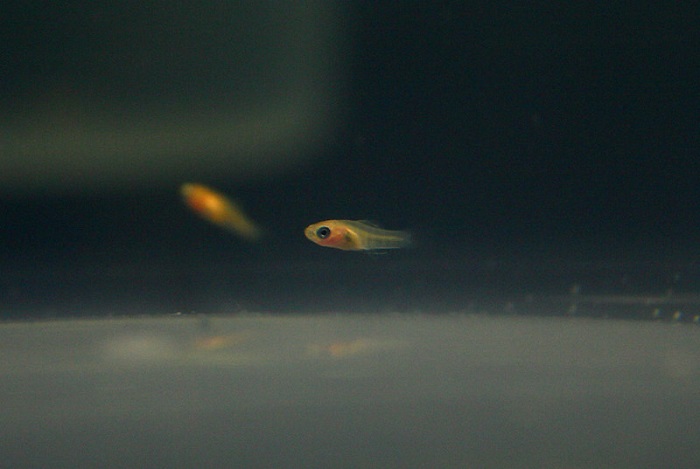
The actual birth process of Molly Fish can be more intense compared to fish that do not give birth to live young. As livebearers, the proportionate size of the fry that a Molly Fish has to pass out her body whilst giving birth is comparatively large.
Along with the fry, you may see other things emerge from the mother molly’s uterus during the birthing process. The most noticeable of these is the yolk sac of the eggs. This gives the baby fish something to feed on and provides extra nutrients. This tends to be a yellowish color and will quickly dissipate in the water as the fry pass out your mother fish’s body.
Once the fry have emerged, they generally start swimming within a few seconds of entering the water. It may take as long as 24 hours for the mother Molly to give birth to all of the fish fry and during this time, she can become very exhausted.
Once you do not see any more fry emerging from her body, you will also see contractions become less intense. At this stage, it is best to wait a few minutes and then feed her some high-protein food so she can regain her energy.
Author’s Note: Don’t worry! If you’ve made it this far, and your mother fish is still healthy and most of the fry have been delivered alive, then congratulations – although mollies are easy to breed, this is a sign your tank conditions are great and your fish feel safe and are physically strong and healthy.
Bottom Line
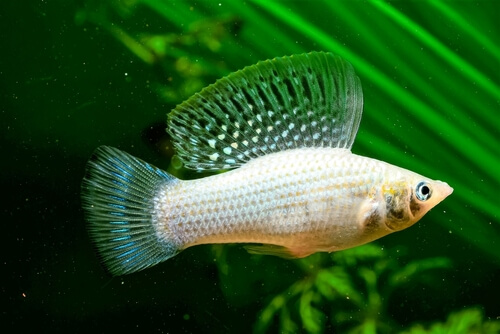
Overall the idea of your fish giving birth to live young may sound like it requires a lot of care and intervention on your part. However, like many natural processes in the aquarium, it is actually very hands-off and does not require much input from you.
Therefore, even if you are a beginner who has never bred your fish before if you do end up with a pregnant Molly Fish, it’s most likely everything will go off without a hitch.



